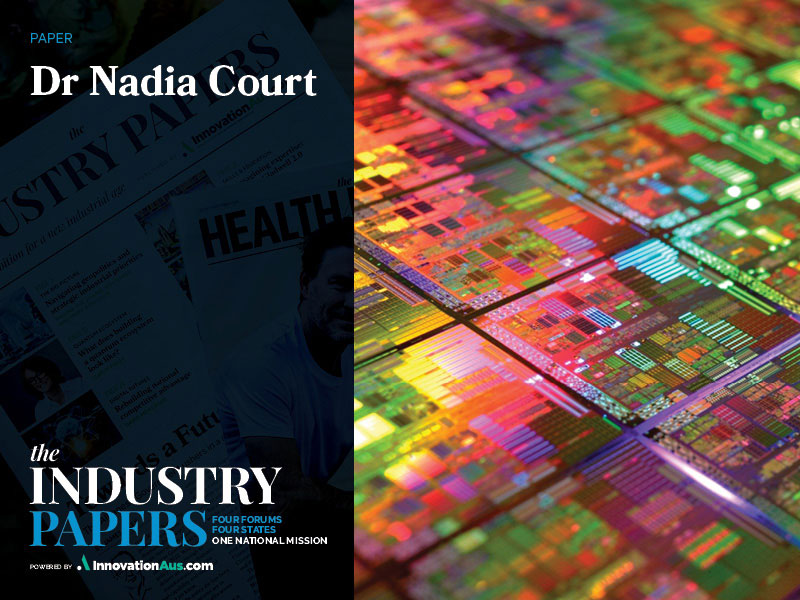Any casual conversation about Australian invention usually starts with the humble Hills Hoist – a simple mechanical system known for its practicality and durability.
The conversation often progresses to more recent and far more advanced and deep tech innovations with transformational impacts across the world.
Australia’s contribution to the invention and development of high-speed wi-fi revolutionalised global wireless communication. The black box flight recorder is now mandatory in aircraft worldwide, critical for investigation of aviation incidents and improving aircraft safety. The cochlear implant, an Australian invention commercialised by Sydney-based Cochlear, has had a transformational impact worldwide on people with profound hearing loss.

Often overshadowed by the application of the technology is the fact that Australian contributions are often a complex systems solution enabled by semiconductor technologies.
The semiconductors or “chips” used to implement Cochlear’s system are designed to be small, highly fault-tolerant and energy efficient. These specialised chips and others, including those used in wi-fi devices, are manufactured at scale globally.
Australian innovations relying on semiconductor chips extend beyond terrestrial use.
In 2004, the Mars Rover explored Martian surfaces using chips made and designed by Australians for crucial tasks such as navigation and communication.
A conversation about chips or semiconductors often turns to Taiwan and its global dominance in the manufacture of the most advanced semiconductor chips. However, Australia’s contributions in these applications are in the system concepts and enabling breakthrough integrated system designs that exploit the most appropriate advanced manufacturing technologies.
The mention of Semiconductor Sector Service Bureau (S3B) generally elicits an abrupt and honest response, “what Australian semiconductor sector?”
Australian achievements in chip design are not perceived as successful compared to the manufacturing successes of Taiwan Semiconductor Manufacturing Company (TSMC) with its very visible facilities, history, and investment.
The chips manufactured by TSMC and others drive everyday products like washing machines and cars. They also power sovereign stellar startups like Gilmour Space, a provider of Australian-made launch vehicles and satellite platforms that lower the cost of escaping the Earth’s orbit.
In Australia, we are regressing in our participation in the already small part of the global semiconductor supply chain we had previously excelled in.
As the Office of the NSW Chief Scientist and Engineer reported in 2020, Telstra’s ground stations depend on imported and internationally designed semiconductors. Meanwhile, Cochlear – while committed to advanced manufacturing of its systems on-shore – in recent years has shifted much of its chip design expertise overseas due to a shortage of local talent.
Shrinking our presence in the global semiconductor value chain has allowed us to sidestep the perceived risk of trying to compete with global semiconductor superpowers, but with it we lose opportunity.
There is a sense that any attempt to be part of the global semiconductor supply chain requires investment that matches the multi-billion-dollar EU and US Chips Acts. The lack of investment actually exposes Australia to the risk of being locked out of supply chains.
The ledger shows we’ve cut investment in designing and manufacturing semiconductors, including R&D, production facilities, and supply chain management. We miss the immense value generated from owning and controlling these technologies and processes.
Chips are critical to everything that is critical to Australia
Semiconductor materials, chips and technologies are an ultimate enabling capability driving advances in many other technologies and sectors, including quantum. In fact, quantum and semiconductors are so deeply intertwined, the most advanced semiconductor chips on the market rely on decades of developments in quantum materials.
Similarly, the quantum technologies and devices that Australia has invested heavily in will rely on advanced semiconductor manufacturing techniques and decades of industry experience.
The Australian government’s and Queensland government’s combined $940 million investment in PsiQuantum aims to develop a commercial-scale quantum computer by 2030 and strengthen international strategic ties.
As Australia’s chief scientist Dr Cathy Foley articulates, our pockets of brilliance are “a step towards moving quantum computing closer to the assembly line”. Developing quantum computer hardware has the potential to solve large problems in renewables, healthcare, and mining.
Semiconductor chips can also enable new types of medical devices, enhance remote sensing and scanning for mineral exploration and agriculture management, and enable more effective pollution detection and management.
They can bolster defence capabilities and are fundamental to advances in AI and robotics. Advanced power semiconductors can drive electrification and the clean technology revolution.
These are opportunities that play to Australia’s strengths in systems engineering, which are vital for both semiconductor innovation and sustainability.
Modern vehicles are sophisticated machines with thousands of semiconductor chips. For example, a smart train may use around 15,000 chips to control everything from propulsion and braking systems to automatic doors, making it a computer on wheels. Similarly, a typical modern car contains up to 3,000 chips, controlling various functions and features.
Standing proud among giants
As reported by the Australian Strategic Policy Institute in 2022, we have a narrow “moonshot” window to build a local semiconductor industry and dominate high-tech manufacturing niches that support this advanced technology future.
Australian businesses are understandably reluctant to take on and manage the risks inherent in the semiconductor sector, which requires highly specialised talent.
The dearth of large companies in the sector indirectly adversely impacts innovation because there are few local role models, success stories, or even representative end-customers for early engagement and market intelligence.
Additionally, there are no logical local acquirers for their business or products, which exacerbates the challenges faced by startups and scaleups.
I was asked to lead the S3B to forge vital connections – linking supply chains, investment opportunities, and customer access. With an initial four-million-dollar investment from the NSW government, we open doors to market intelligence and strategic partnerships with labs, institutions, and chip fabricators across the global supply chain.
Our mandate is to support and grow the semiconductor sector from bare materials all the way through to end-user products. There is plenty of room for us to grow in a semiconductor market forecast to be worth US$1 trillion by the decade’s end.
Australian participation in the global semiconductor supply chain does not require emulating TSMC and Taiwan in building a “super foundry”, which drives the production of 90 per cent of the world’s super-advanced semiconductor chips. Taiwan’s approach is considerable in complexity, ambition, and scale, with impressive results. TSMC’s success contributes significantly to Taiwan’s economy.
Meanwhile, Singapore’s semiconductor sector contributes around seven per cent of its GDP (A$36 billion), employs 35,000 people, and holds roughly 11 per cent of the global market.
Yet Singapore’s economy is less than half the size of NSW and only started to target semiconductor technology around 20 years ago.
In both cases, long-term government policy and sustained investment have contributed to their success. In Australia, there is little appetite for the level of commitment required to establish and maintain a capability at the frontline of semiconductor manufacturing technology.
However, that is not what is needed to build a successful industry.
NVIDIA, the creator of chips which power ChatGPT and currently one of the world’s most valuable companies, operates as a fabless semiconductor company. It designs and market chips but outsources production to specialists like TSMC.
This strategy leverages top-tier manufacturing and meets the rising demand for AI, ensuring steady growth despite traditional market cycles.
While these titans cast a long shadow over the rest of the world, we can shine our innovation headlights on the gaps and crevices that permeate this complex arena.
Because of our history in the development of scientific systems, we have pockets of expertise in fields like radio frequency (RF) communications, millimetre wave technology, photonics, and radar systems.
Morse Micro and Millibeam are two examples of local companies who are making strides as fabless semiconductor companies, building on Australia’s strength in communication technology.
A vote of confidence in Australian strengths in chip design can be seen in international companies such as Broadcom and AMD maintaining a presence in Australia.
Bluglass has developed globally recognised leading-edge semiconductor manufacturing technology to deliver photonic chips across the industrial, defence, display, and scientific markets.
By focusing on breakthrough applications, leveraging existing strengths in systems engineering and supporting innovators to carve out a competitive edge with semiconductor technologies through collaborative partnerships Australia can accelerate its participation in the global semiconductor value chain, without directly competing with high-volume manufacturers like TSMC or Samsung.
A notable example is a recent partnership between Morse and Australian technology company Zetifi. Their solution gives farmers the ability to embrace precision agriculture with remote monitoring and prepare for the introduction of autonomous machinery.
Companies like Diraq, which focus on quantum technologies, are leveraging the local design strengths of Perceptia Devices, to develop novel ultra-low power semiconductor solutions for cryogenic control electronics.
Advanced Navigation, which develops navigation systems based on photonic chips, could gain a competitive edge with customised semiconductor solutions, offering more functionality at lower costs.
The company has committed to onshoring as much of its manufacturing capability as possible, integrating their systems of electronic and photonic components into Made in Australia products.
Researchers at the University of Sydney recently developed a photonic chip that integrates electronics and light, significantly expanding bandwidth and control. This innovation, integrating heterogenous components into a complex system, like fitting Lego blocks, highlights our potential for advanced systems manufacturing.
Investments are already happening which will give us the ability to integrate state-of-the-art heterogenous semiconductor technologies in Australia.
Although supporting SMEs in engineering and prototyping is more affordable compared to the capital investment needed for an advanced TSMC style foundry, our innovative SMEs still need multi-million-dollar funding for projects which typically take a minimum three to four years from design to manufacturing.
Strategic investments, centralised orchestration and collaborations can bolster our capabilities around areas such as the above. As a bureau, we aim to serve a national audience and work with universities, companies, startups and state governments from across Australia. But a NSW-funded entity has its limitations.
While we rely on our relationships with the United States in AUKUS and Five Eyes for technology sharing and defence enablement, the fragmented nature of global supply chains means we need to develop our own relationships and be more self-reliant.
Australia urgently needs to develop and invest in a semiconductor strategy.
We require national coordination, policies, and incentives to encourage investment in semiconductor innovation. We must address the high costs and long timelines of projects with large-scale investments.
We should leverage existing investments in quantum and nationally significant infrastructure to support research and development, and drive innovation.
Our direction is inspired by the progress of the US CHIPS and Science Act but tailored to our strengths to be competitive in emerging markets in a rapidly growing global sector.
While we cannot ignore the complexity and challenge that awaits us, we should relish the opportunity to reassert ourselves and return to our origins, solving critical system problems and addressing emerging global needs.
Dr Nadia Court, director, Semiconductor Sector Service Bureau (S3B). Nadia was the technical director of the Research and Prototype Foundry, the University of Sydney’s micro and nano fabrication facility, and the Sydney hub of the NSW node of the Australian National Fabrication Facility (ANFF). She has worked in various roles with ANFF since 2012, both at UNSW and the University of Sydney, and has also worked in the UK on printed electronics and optical communication technologies for the defence industry.
This article is part of The Industry Papers publication by InnovationAus.com. Order your hard copy here. 36 Papers, 48 Authors, 65,000 words, 72 page tabloid newspaper + 32 page insert magazine.
The Industry Papers is a big undertaking and would not be possible without the assistance of our valued sponsors. InnovationAus.com would like to thank Geoscape Australia, The University of Sydney Faculty of Science, the S3B, AirTrunk, InnoFocus, ANDHealth, QIMR Berghofer, Advance Queensland and the Queensland Government.
Do you know more? Contact James Riley via Email.

